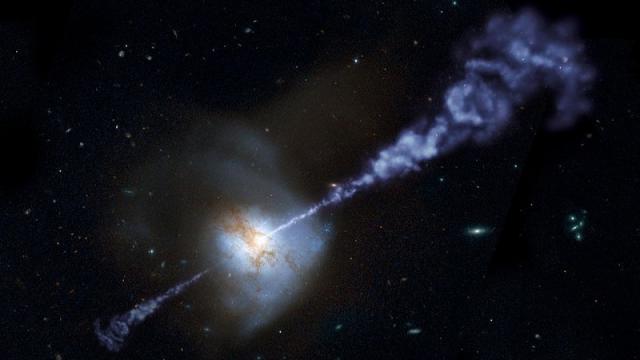Despite their popular reputation as dark inescapable pits, black holes really put out a lot of energy. They thrust out jets of matter. They get matter to heat up through friction as it swirls around them. And, in some cases, they contribute to bursts of incredibly high energy photons, thanks to a phenomenon first encountered in the 1920s here on Earth.
It’s well known that anything that falls beyond the event horizon — the point of no return for a black hole — isn’t going to be seen again, at least not in any recognisable form. This is what makes black holes resemble huge pools of darkness. But surrounding these pools of darkness are intensely bright lights. Black holes provide power for a great deal of the space around them. How? By reversing a process that was discovered nearly a century ago here on Earth.
Though the universe isn’t dense, it does have a fair scattering of photons throughout. Those photons are often at energy levels that put them far below the required level for the visible spectrum. But photons and electrons have a long-established relationship. When they interact, they can pass energy one to the other.
This phenomenon was discovered on Earth by one Arthur Compton — a physicist working in the 1920s. It’s hard to find any area of early twentieth century physics not touched by Compton. He worked on ferromagnetism, he helped isolate plutonium for the Manhattan project, he figured out what cosmic rays were, and he worked with gamma rays. Sadly, he was limited to this planet, and on Earth, in general, photons have a lot more energy than electrons. He noted that these photons gave their excess energy to electrons, and called the resulting boost to electron velocity Compton scattering.
What we see near black holes is inverse Compton scattering. Low energy photons, well below the visible spectrum, get hit by jets of electrons speeding out of black holes. After the collision, the electron goes on its way travelling far more slowly than it had before. The transfer of energy accelerates the photons well into the x-ray spectrum, lighting up the entire area for astronomers with the right kind of telescopes. Compton’s earthbound discovery of the relationship between photons and electrons has helped scientists today explain why supposed “black holes” are actually enormous power stations for the universe around them.
